The Amateur Mycologist #38 - The Lichen/Fungi Of Geneva, Switzerland ('s Airport) - Xanthoria Lichen, Corprinoid Mushroom, Likely Auricularia Species, And More
These posts are not for foraging. They are intended for entertainment and intellectual satisfaction only. These posts are not a field guide nor comprehensive in any way - their accuracy is not assured in any way. Do not eat wild mushrooms unless you are a professional, have substantial professional assistance or have a wealth of personal experience with a specific species. Do not make any foraging decisions based on these posts. To do so could be dangerous or life threatening.
This post makes no reference to edibility or toxicity
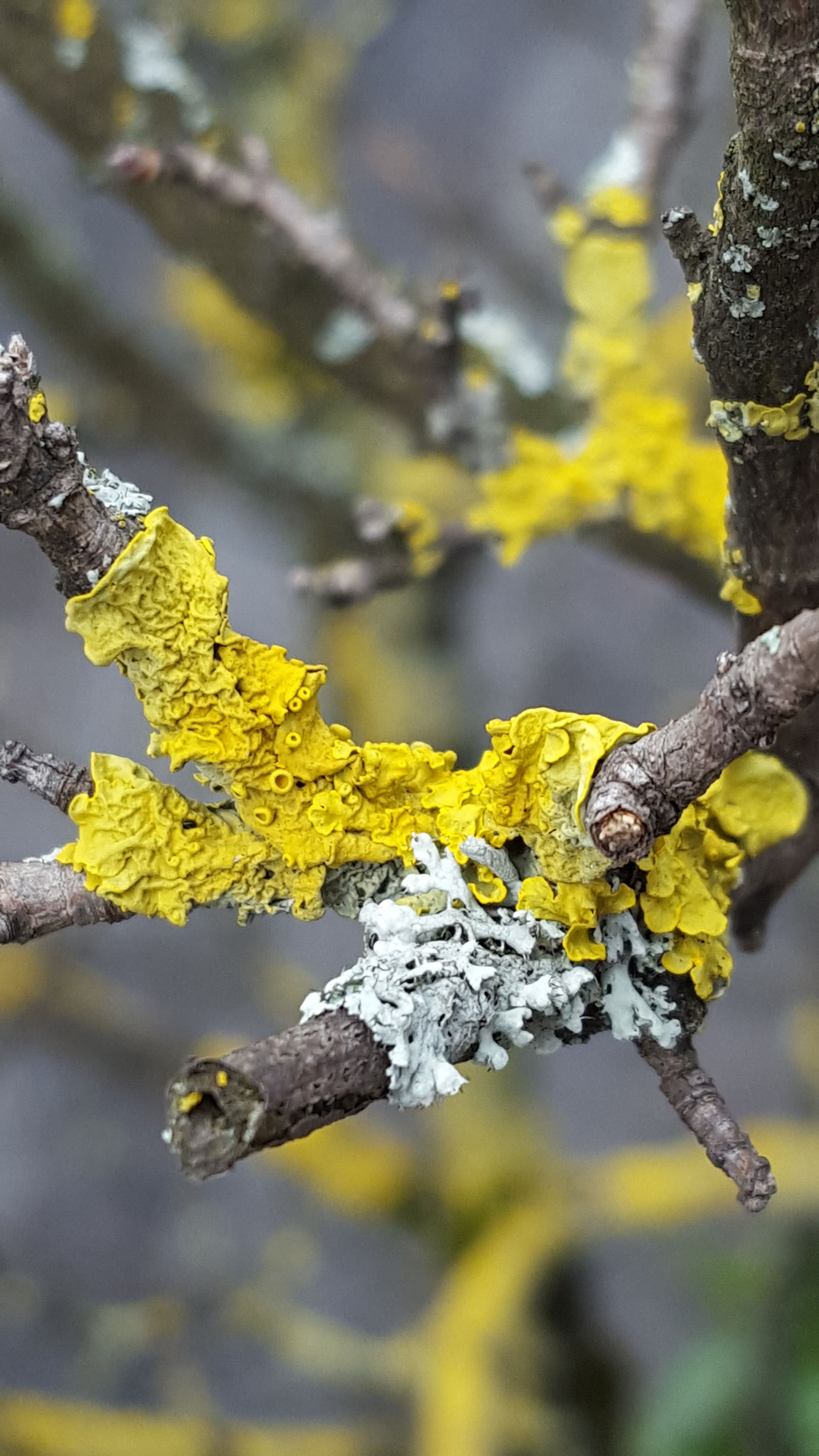
Although it was not, technically, my primary purpose in attending, of course my eye was drawn to the natural beauty of the area around CERN in both France and Switzerland.
The air was clear, the valley green, the mountains tree covered and snow capped. Every tree I saw appeared to be old growth, overcome with vines and algae. Especially beautiful are the many giant Sycamore trees - the Plane trees in the genus Platanus if I'm not mistaken. They lined a lot of the country roads, and were often covered in a variety of living things.
Most prevalent throughout the countryside - and as it turned out, even right outside the Geneva airport - were the many and varying lichen growing positively everywhere in great and vibrant abundance. From almost the moment I arrived and started to drive around in an exhausted haze, I noted the sheer variety of lichens growing on nearly every single tree.
Although I wasn't able to get in a full day hike, the area was so replete with life that even the curb outside the Geneva airport proved quite fruitful. That is where I found the following species and took photos.
Before we go any further - let's talk about what lichen even is.
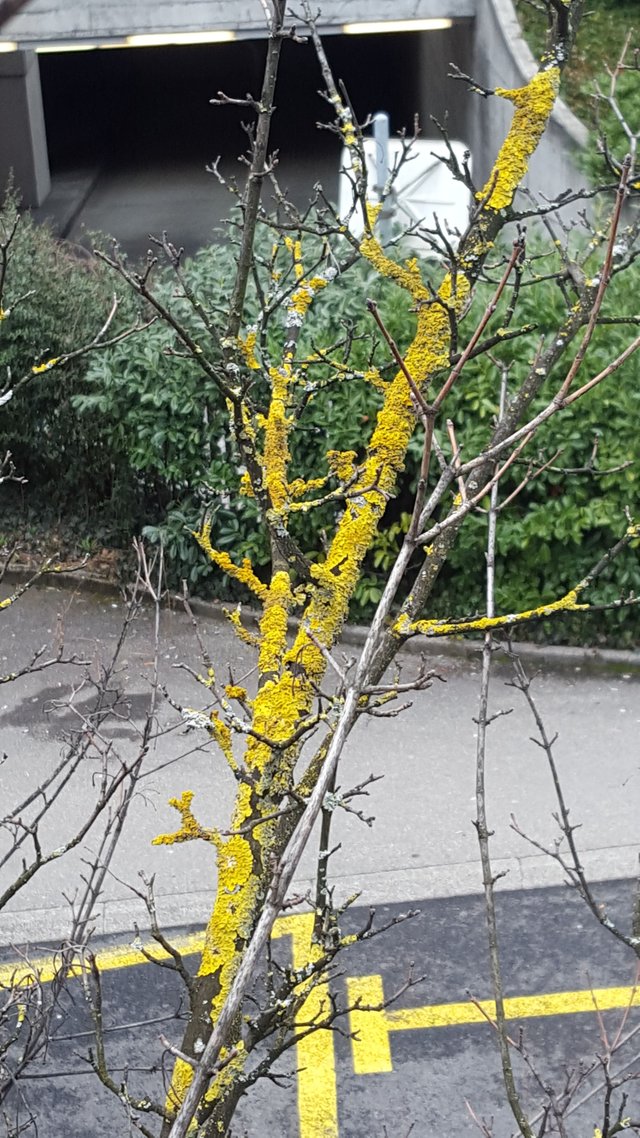
So far we have dealt in this blog with several different types of organisms.
Primarily we've dealt with macro-fungi - big 'ole mushrooms, like the bolete or the morel. We have also found and grown a couple of myxomycetes, a different kind of organism altogether, although they are frequently mistaken for particularly strange fungi. We've also begun to deal with various forms of fungal mold, the many-faced, many specied, utility workers ready to grow on, and decompose, any and all organic matter.
Lichen's are something altogether different. A Lichen is a symbiosis between one or more fungal species and an algae and/or cyanobacteria species. The different organisms essentially join forces and live together in a complex give and take relationship, although the specific configuration and number of species involved can vary.
More than likely, the lichen featured here is in the genus Xanthoria. It may not be precisely Xanthoria parientina, but it is sufficiently similar to that species, which is fairly cosmopolitan, that we can use it as a reference point.
It's important to point out that Xanthoria here is referring to the fungal component of the lichen. In the case of X.parientina, the fungus is likely paired with an algea, often a Trebouxia species. The actual structure of the lichen is, generally, predominantly made up of the Xanthoria fungus, however a significant percentage also consists of the Trebouxia symbiote.
The question is, what benefits are there in the symbiotic relationship present in lichens?
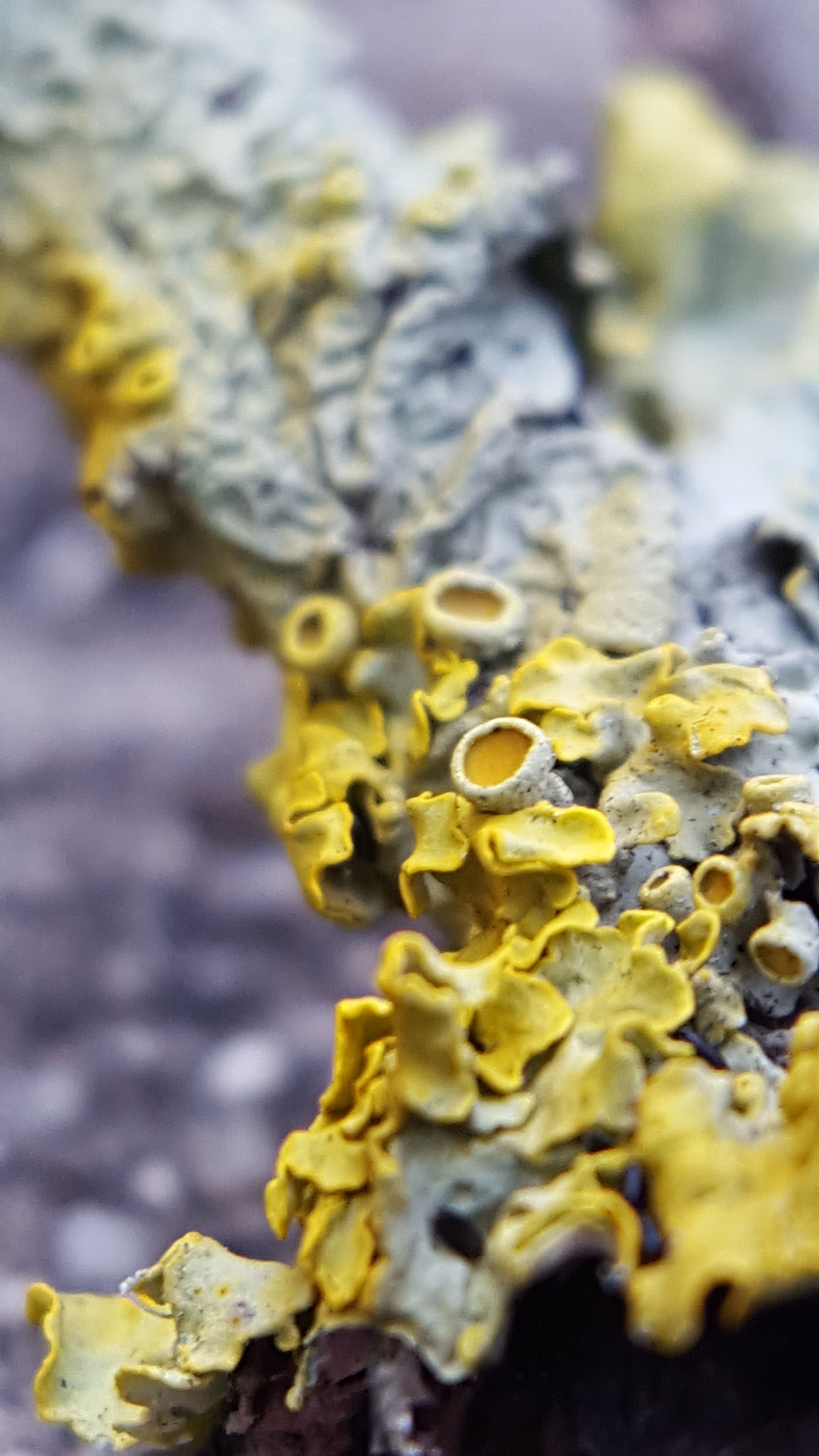
Fungus is not photosynthetic
There is no chlorophyll in fungi, which means they cannot engage in photosynthesis and directly turn the sun's light into energy. Instead, fungi are more like humans than plant life, insofar as they need to absorb their nutrients from other living things, rather than from the sun itself.
In the case of lichens, the fungal species involved have found a solution to their lack of photosynthetic abilities - let a photosynthetic organism move in!
In the case of X.parientina, that organism is usually in algae, but sometimes it is an even smaller form of cyanobacteria. What matters to the fungus is that the symbiotic organism is photosynthetic, thereby allowing the sunlight to be absorbed by the organism, which are turned into carbohydrates and then stolen by the fungus.
Now, what do the non-fungal lifeforms get out of this relationship? Protection. A lot of the symbiotes growing in lichen are not as physically hardy as the fungus - often being more individually susceptible to damaging UV or inclement weather. However, X.parientina is downright hardy - it can even survive a variety of environmental pollutants - and when the small cells of the algae or bacteria nestle within the filamentous hyphae of the fungi, they are protected from the outside world.
Now, just because two or more organisms live symbiotically, doesn't mean they both benefit equally. In this case, the fungus almost certainly gets a greater net gain of energy from the relationship.
But whatever balance fungi and algae have struck, is working, well, because this stuff is positively everywhere in this area of Europe.
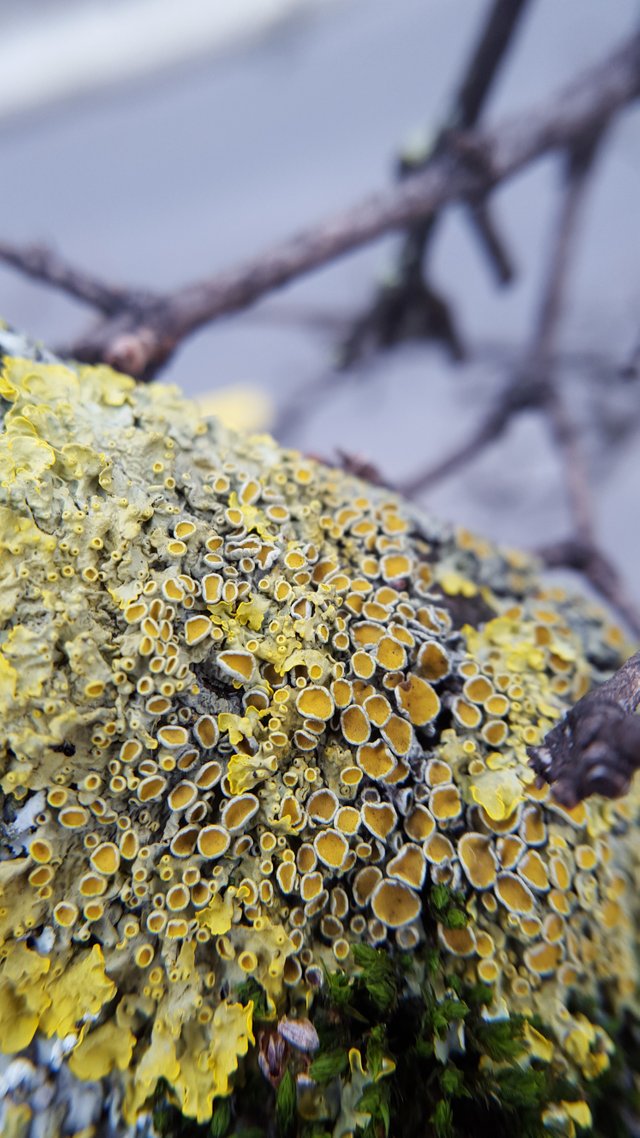
How awesome are these guys?
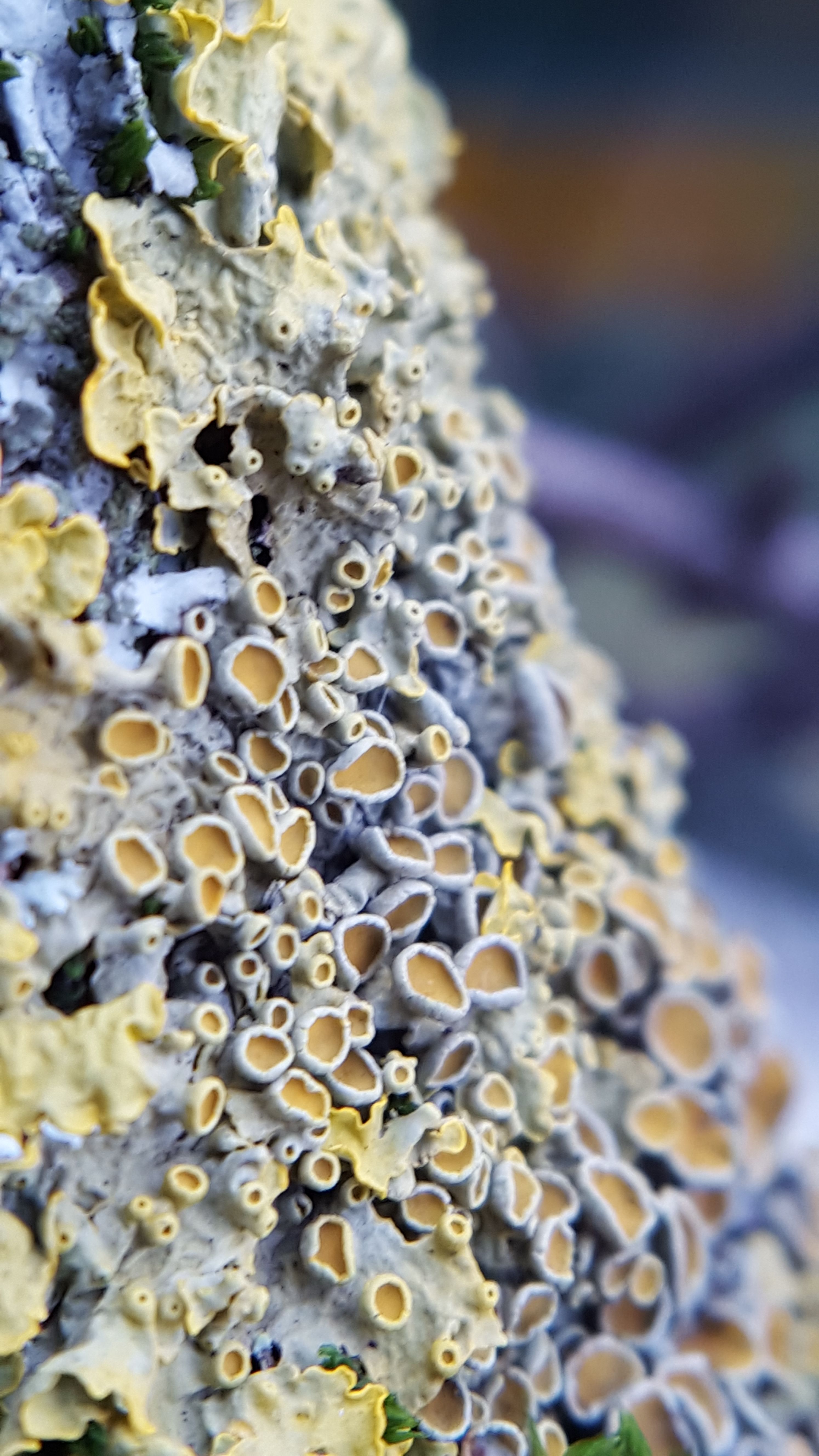
The yellow coloration provides a defense against UV radiation from sunlight, which would otherwise scorch the organism on hot days.
Those wide saucer shapes all over the lichen here are, I believe, apothecia, or the fruiting bodies of the this particular species. Now, bear in mind, this could be technically incorrect. The truth is lichen's involve a series of terms which are specific to their study. Like my first foray into myxomycetes, this is going to require the purchase of some reading material in order to more fully understand.
But, broad strokes, this species of lichen is definitely quite health, and reproducing quite well, as manifested from the sheer number of fruiting bodies on its surface. It appears to reproduce by dispersing spores, like other fungi, which then seek to land on other pieces of wood and essentially match up with an ideal symbiote. Apparently, the fungus will readily match with even a less than ideal symbiote in order to bide time until a perfect pair can be found.
But, in the Canton of Geneva, apparently "perfect" pairs must be pretty common, because there appears to be over 600 taxa of lichen in the Canton alone. The ubiquitousness and shared traits of this particular species militate toward Xanthoria, but in truth, who knows.
The airport discoveries were not limited to Lichen.
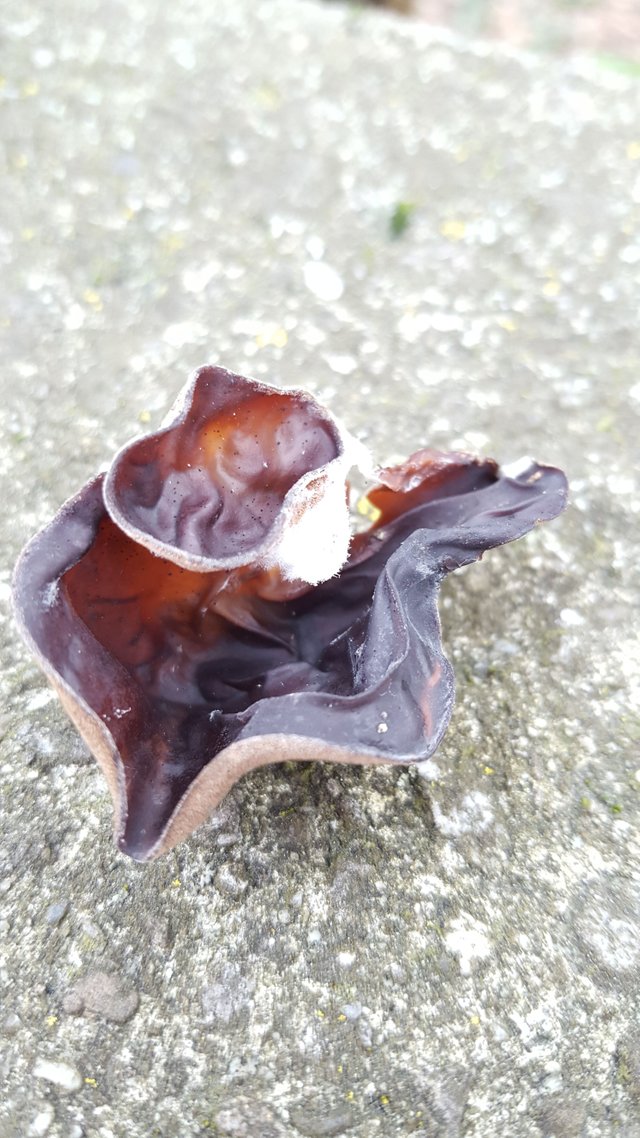
An old, shriveled Jelly Ear mushroom, probably in the genus Auricularia
These guys are saprobic mushrooms growing on dead wood, and species within the genus are found all over the world. In this case, they were growing on one of the roadside trees on the long walkway leading away from the airport and metro station in Geneva. You can see it's "ear-like" quality very clearly in this photo.
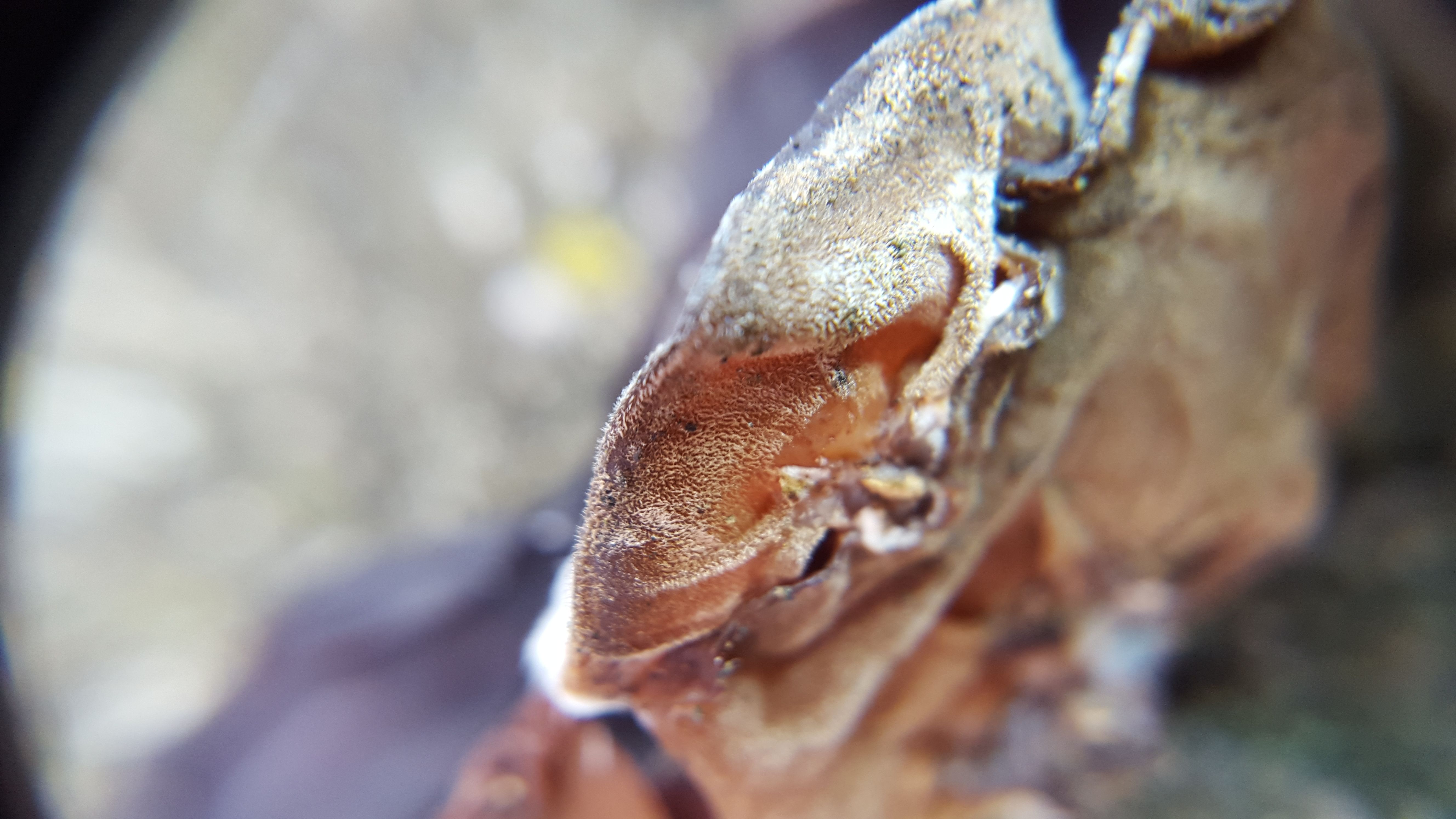
A close up of the outer portion reveals a minutely hairy, textured surface.
The color is lighter on the outside and darker on the inside - and generally the darker, interior/downward portion is going to be the fertile spore surface. A spore print can be retrieved from more fresh Jelly Ears, although obviously I didn't have time to get one here, and it was likely to old to boot.
It's important to note, although I'd have loved to, I didn't bring any of these home with me - I actually think most of them were pretty cosmopolitan species, and of course we are all covered in their spores in general anyway - but better safe than sorry when it comes of questions of ecological contamination.
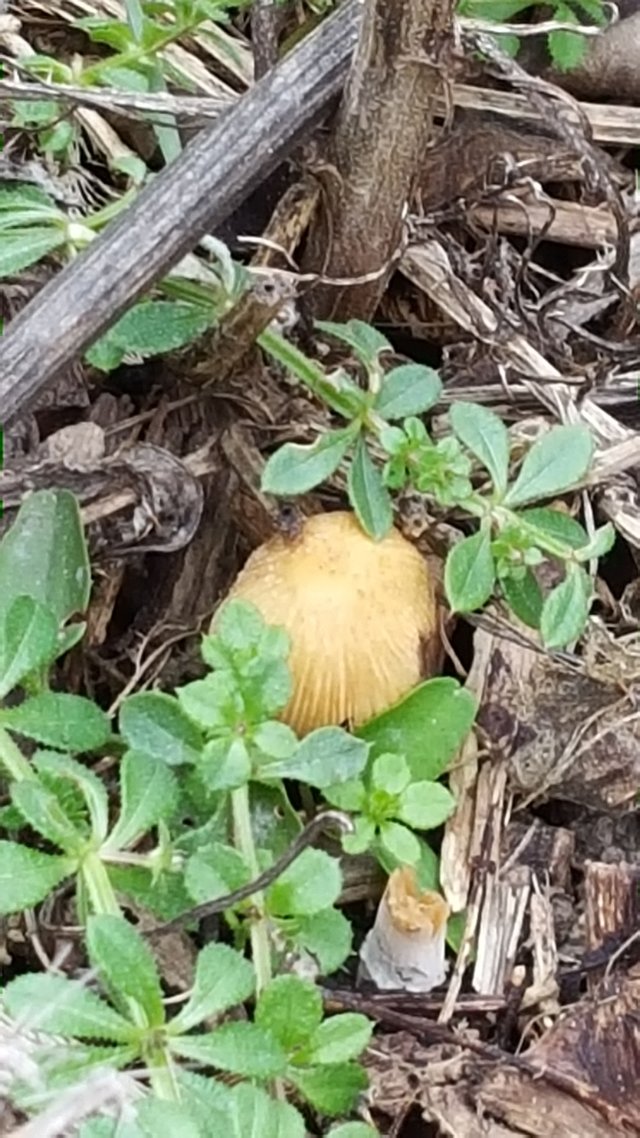
Here we have a tiny Coprinoid species peaking out from the grass.
I tried to get ahold of this little guy for clearer photos, but he was about 4 feet away from the base of a 4 foot wall. Even getting this photo required planking on the wall and teetering forward with my camera. It was, I have to say, not worth it.
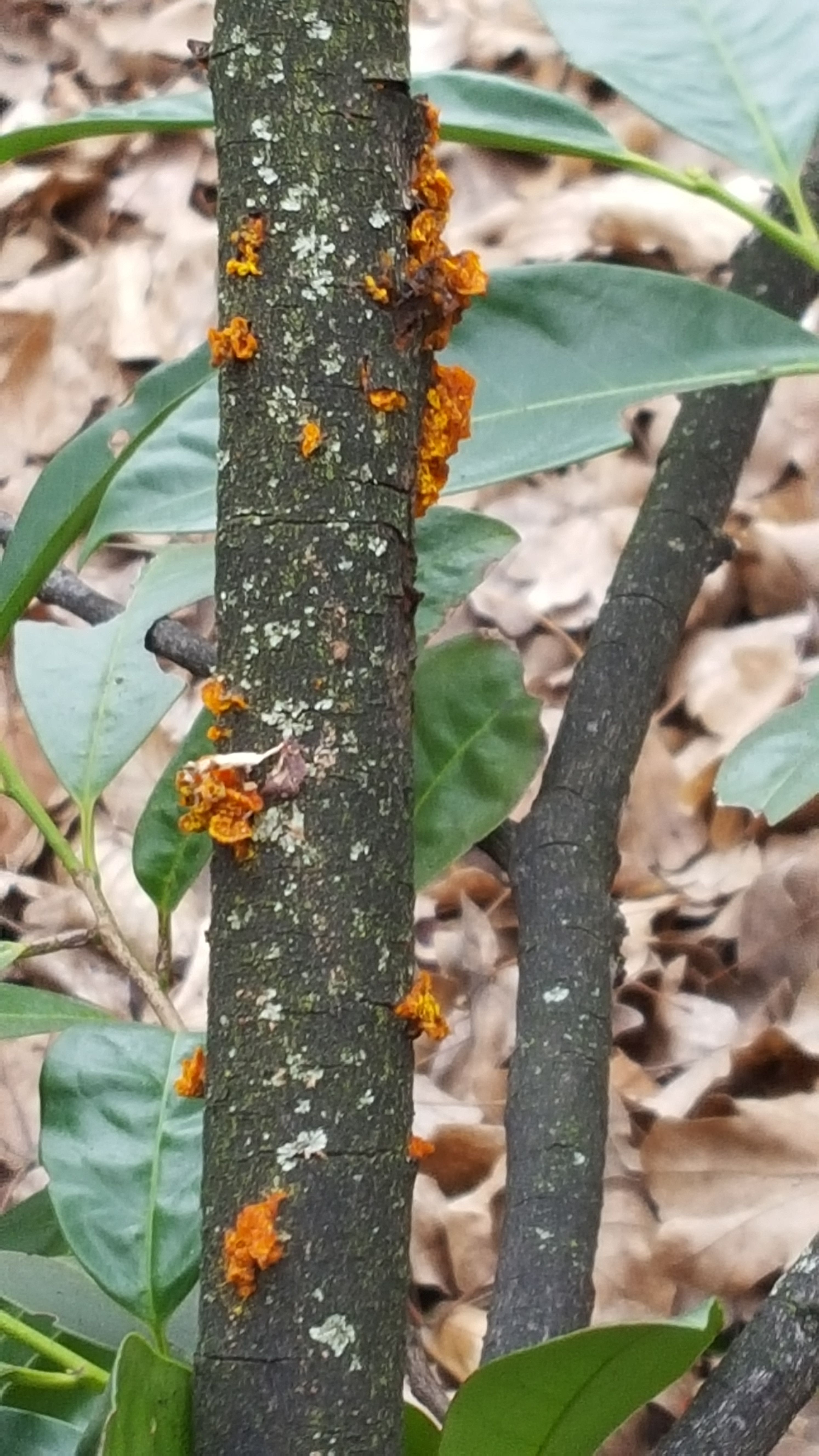
Similarly, this orange organism was too far away to get a better look and I can't identify it at a glance.
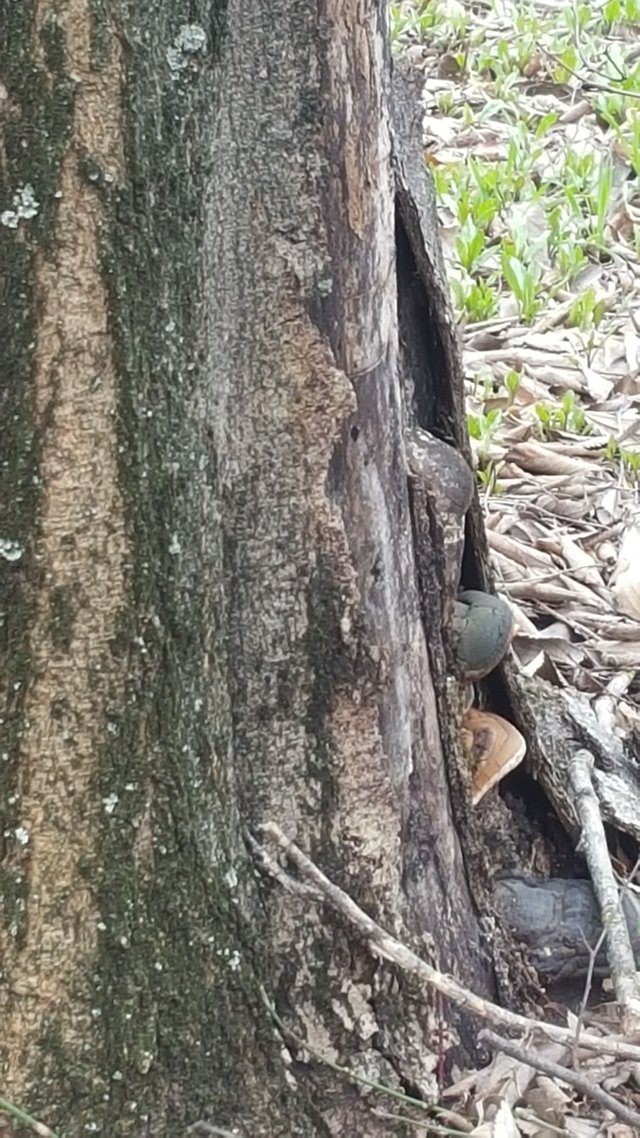
Lastly, I thought it was fitting to point out the discovery of a butt root fungus on one of the trees abutting the local street by the airport.
The tree was nearly or entirely dead all around, and these small fruiting bodies at its base - possibly a Ganoderma species, but I'd bet money saprobic, butt rotting, and woody in texture - mean the corpse is becoming progressively weakened. Not the kind of thing you want to see on a tree beside an active street. As the grim reaper of street trees, I was tempted to report the guy to the local municipal authorities - but then I realized: (A) I didn't know who to call and (B) that was crazy, and so I didn't.
But, it's worth noting that this was the only butt rot fruiting body I saw during the entire trip, and trust me, I was looking. This bodes very well for the local tree health - and, I would guess, speaks highly of the local population's treatment of their trees.
In sum, even in a 50 meter stretch of dirt along a very active street, next to an airport, Geneva revealed a wide ranges of fungal life. Of course that wasn't the point of my going to Switzerland - and boy did I enjoy the trip's intended purpose - but, this was a nice ancillary investigation. Hopefully in the future I will be able to return and spend more time exclusively searching the nearby mountains and valleys for what I'm sure are some amazing local fungi.
Photos And Videos Are My Own:
Microscopic photos were taken using an AmScope SM-4TZ-144A dissecting microscope and an AMScope M150B entry level microscope. The camera lens is also AMScope, MU300.
Information Sources
Efforts were made to identify the species using the following resources (as well as some linked within):
[1]Xanthoria parietina via wikipedia
[2]Xanthoria parietina via Lichen Portal
[3]Auricularia Genus via wikipedia
[4] Auricularia auricula via first-nature
[7]What are Lichen, US Federal Forest Service
I was literally waiting for this post!
I think there are very few people who can find mushrooms and lichens next to an airport!
You might be right about the more conventional fungi, that took some searching.
But the only people who can't find lichen on the trees by the Geneva airport either aren't or literally blind. :D
I'm pretty sure it's usually the former :).
Rectification: find AND catalogue ;-D
I am definitely part of the group of people... who can't because they don't pay attention :D
I do recognize both types of lichens in your first picture from home, they happen to grow on everything from treebark to large natural stones.
But that's fine, they are an indicator for good air quality after all, aren't they?
In general yes. Lichen are certainly a positive sign in general for the health of local ecosystems.
Having said that, this particular genus seems highly resistant to pollutants - which is to say, it's presence wouldn't be a bad sign for the cleanliness of a local environment, but neither would it be definitively indicative of low pollution levels.
I heard Xanthoria species grow on rocks less readily overall, and perhaps with a preference to rocks regularly bathed in bird poop. Just a funny anecdote.
so beautiful and very cool vote me yes
Wow. really beautiful photography my big friend @dber i like post and resteemed
the mushroom cage can be toxic, I agree with your opinion, we must be careful to eat mushrooms.
Really enjoyed seeing those close up shots of the lichen they are pretty incredible looking, could easily think some were from under water, hence the algae connection. Thanks for the links, there is so much to know about Lichen I'm impressed as always, two forms of reproduction, going to need time to read them both.
Being A SteemStem Member
Hi @dber, Very interesting post on the lichen/fungal diversity of affected area. Nicely organized information. Really loved the way you presented the pictures of such beautiful and lovely microbial creatures. I love these being a Microbiologist.
Just followed you.
If you are interested in such posts related to Microbiology/Bioscience , please follow me @drvnpatel , and by the way, I just posted a link to a quiz from my website that's very interesting for sure.
Check it out here : https://steemit.com/steemstem/@drvnpatel/let-s-play-a-quiz-on-food-microbiology